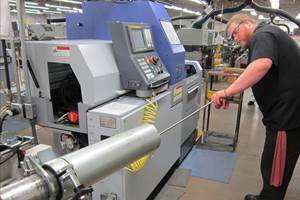4 Reasons Work Instructions are Useful
What is the definition of work instructions? Work instructions are created to guide workers in four key quality areas: training, reference, problem solving and continuous improvement. Use these four reasons to write useful work instructions.
Take a walk through "Any Shop USA" and observe the actions being taken to serve the customer. Rarely will you see someone with an open manufacturing work instruction book reading about how his or her particular task is to be completed. The vast majority of shop employees know what it takes to ensure that a high-quality product arrives at the customer’s dock on time. They have been instructed in specific tasks, and they follow those instructions.
So what is the purpose of documented work instructions? Besides having them available for audit review, why do such documents exist? Work instructions are created to guide workers in four key quality areas: training, reference, problem solving and continuous improvement.
Each of these areas can be directly related to the Deming Cycle, a cycle that identifies fundamental quality planning as "Plan-Do-Check-Act." It is important to establish (plan) the instructions that your people must execute. The references must then be effectively implemented (do) so they are accessible to personnel. Documentation must be verified (check) so the instructions assist your problem-solving methodology. Finally, it is important to use (act) what has been defined in order to continuously improve.
Reason #1. Training (Plan). Training is the essential first step to ensuring that people are competent in their duties. It is important to define, within the quality planning activities, the type of training that each function is to receive. It is equally necessary to ensure that the trainers are executing the plan, including improvements made to the instructions.
New employees should start their training with the process expert so they can observe how the process should be performed. It is here that detailed training discussions and hands-on activities take place between the expert and the trainee. The trainer uses the work instructions so new employees understand the basis for the tasks they are performing. The process is an opportunity for additional review of the work instruction content. The veteran can reaffirm the defined steps, and the new employee can confirm the validity of the process.
Reason #2. Reference (Do). This quality activity should focus on both access and format of the instructions. The documentation must be implemented so workers are not wary of having to locate the information relative to their areas of responsibility.
Write out how the instruction is to be performed specific to each core task.
Once employees have been trained and have demonstrated that they can be effective performers, you must ensure that the work instructions are available in case of questions. The instructions must be presented in an easy-to-understand format so that access and review will not take up valuable time.
Write out how the instruction is to be performed specific to each core task. Avoid defining why the activity is performed. There should be no need for an expert organization to reaffirm why core tasks are needed. If the "why" information must be defined, keep that separate from the work instructions and make the additional information available as reference-only training documents.
Reason #3. Problem Solving (Check). Problem solving is a quality activity that focuses on ensuring that the supporting processes are properly defined to achieve product quality. Documentation should be referenced frequently to ensure that relevance is maintained.
Work instructions are key documents to reference when internal or external nonconformances are identified. Make the review of the work instructions part of the corrective action process. Ask if the supporting instruction properly defines the process, then audit the instruction to confirm proper definition.
The operator/employee cannot be held fully accountable if the records of training are written to an inadequately defined work instruction. If the task is properly defined, the manner by which training is conducted might need to be revisited.
Reason #4. Continuous Improvement (Act). Work instructions should not be stagnant documents accessed only when auditors ask for them. Reviewing work instructions when improvement opportunities are identified demonstrates that they are "living documents."
Instructions can be improved upon through document reviews, audits, a disciplined problem-solving process and, most importantly, the input from the experts who are performing the tasks. The current documentation should be the starting point for all improvements. Always improve upon existing documentation before creating a new document. Volume does not equate to continuous improvement.Identifying that your work instructions serve four key purposes provides the evidence that your organization practices advanced quality planning. It shows that the organization considers the work instruction process to be more important than just a mandated requirement from the latest quality standard. It also demonstrates that top management understands the importance of ensuring that such documentation is properly created, implemented, used and improved upon.
Related Content
6 Tips for Training on a Swiss-Type Lathe
There are nuances to training a person to effectively operate a Swiss-type lathe. A shop I visited a while back offers some suggestions.
Read MoreThe Basics of Rotary Broaching
This broaching process creates a non-round shape on the inside or outside of a part with a broach tool.
Read MoreMachining More Than Metal
Plastics for medical and industrial applications present different challenges than metals as I’ve reported on over the years.
Read MoreUnderstanding Micro-Milling Machine Technology
Micro-milling can be a companion process to turning-based production machining. This article looks at some of the technologies that go into a micro-milling machine and why they are important to successful operation.
Read MoreRead Next
A Tooling Workshop Worth a Visit
Marubeni Citizen-Cincom’s tooling and accessory workshop offers a chance to learn more about ancillary devices that can boost machining efficiency and capability.
Read More5 Aspects of PMTS I Appreciate
The three-day edition of the 2025 Precision Machining Technology Show kicks off at the start of April. I’ll be there, and here are some reasons why.
Read MoreDo You Have Single Points of Failure?
Plans need to be in place before a catastrophic event occurs.
Read More











.jpg;maxWidth=300;quality=90)










